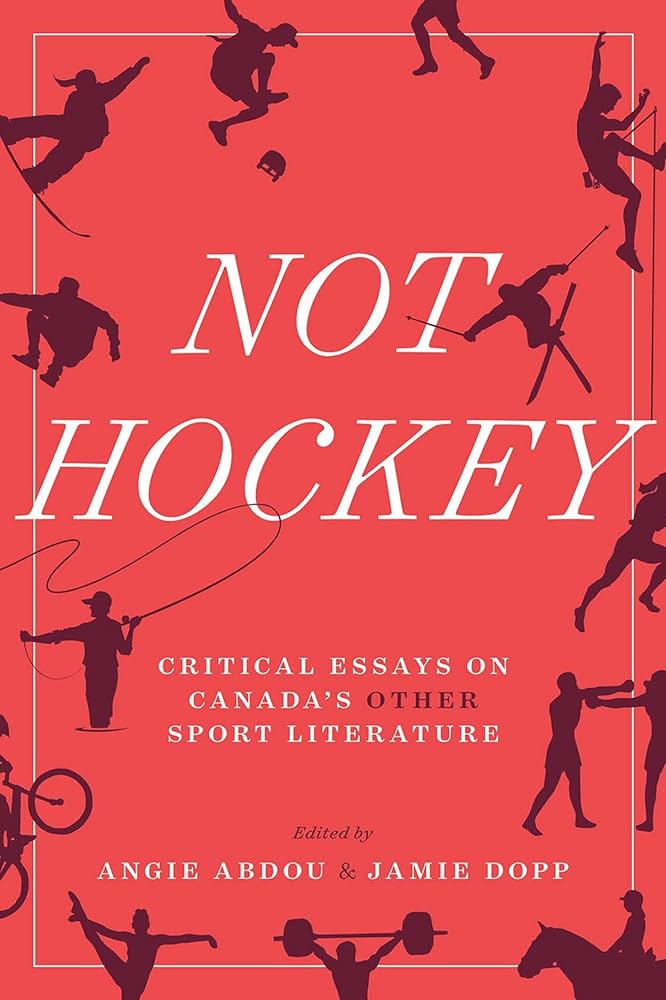Abdou, Angie, and Jamie Dopp (editors), Not Hockey: Critical Essays on Canada’s Other Sport Literature. Athabasca, Alberta: AU Press, 2023, 248 pages. Price: $37.99 Cdn.
Reviewed by Lisa Timpf

Street hockey games played while emulating the moves of one’s on-ice heroes, early-morning practices at the rink, and the tradition of watching Hockey Night in Canada are familiar to many Canadians. That doesn’t mean that hockey can tell us everything we need to know about life in Canada, or about the interplay between sport and culture. In Not Hockey: Critical Essays on Canada’s Other Sport Literature, editors Angie Abdou and Jamie Dopp offer a collection of critical essays about literature pertaining to sports and physical activities other than hockey. Travelling outside the realm of score clocks and player’s benches, these essays examine literature related to a range of activities including skateboarding, parkour, fly fishing, curling, boxing, and Olympic-style weightlifting, among others. Among the works discussed are Timothy Taylor’s The Blue Light Project, Angie Abdou’s The Canterbury Trail, and Ethel Wilson’s Swamp Angel.
The book is divided into three sections: “Niche Sports and Structures: Non-Commercial Experiences,” “Colonialism and Nature,” and “Gender, Race and Class.” In all, twelve chapters are offered. The authors of the individual chapters know their subject matter, and often reference outside theories and writings in addition to providing their own observations and opinions. Some of the chapters are followed by bonus material in the form of interviews with the authors of the studied works, or additional commentary by those writers. For example, Michael Christie, author of If I Fall, If I Die, offers a segment about skateboarding and Olympic sport, while Aritha van Herk, author of Stampede and the Westness of West, discusses rodeo and writing.
One of the chapters I enjoyed the most was “Out of the Ordinary: Curling in The Black Bonspiel of Willie MacCrimmon and Men With Brooms.” This segment, written by Jamie Dopp, includes information about the history of curling in Canada, and explores how The Black Bonspiel of Willie MacCrimmon plays out as a “comic retelling of the Faust legend,” and how Men With Brooms plays with Canadian tropes. Dopp notes that “Each text has an ending that is wildly out of the ordinary, with events that strain credulity, the laws of nature, and, perhaps, good taste.” He adds that the two works “complicate the question of what is ordinary and what is extraordinary in sport and life, while satirizing what is perhaps the most extreme promise of sport: that one great triumph on the field of play can magically transform a life.”
“Immigration, Masculinity, and Olympic-Style Weightlifting in David Bezmozgis’s ‘The Second Strongest Man,’ ” by Jason Blake, was also interesting for its portrayal of the immigrant experience, the sport of competitive weightlifting, and the inevitable fate of the athlete who hangs on too long before retiring.
“ ‘Maggie’s Own Sphere’: Fly Fishing and Ecofeminism in Ethel Wilson’s Swamp Angel,” by Cory Willard, explores Swamp Angel, published in 1954, and how it “provides a valuable illustration of the way the ‘masculine’ sport of fly fishing can be a productive site of personal change and fulfilment for women.”
Other chapters gave me a deeper appreciation for sports I was less familiar with, like skateboarding, ultramarathon, and parkour.
Not Hockey should be of interest to anyone who wants to better understand the power of literature to convey sport’s ability to enhance, shape, and influence our lives. Though subtitled “Critical Essays on Canada’s Other Sport Literature,” the material would appeal to anyone with an interest in sport literature, regardless of whether they reside within or outside Canada’s borders. By exploring activities other than hockey, basketball, baseball, and other high-profile sports, Not Hockey exposes the reader to different experiences, and different sub-cultures in sport. For writers of sport literature, the approaches taken by the authors of the works discussed show us the potential value of moving beyond high-profile sports when examining the interplay of sport and culture.
While I was sitting down to begin work on this review, “Scotiabank Hockey Day in Canada,” a twelve-and-a-half hour broadcasting marathon, was airing in the background. In the winter months in Canada, it’s hard to get away from hockey, but Not Hockey provides a testament to the value of doing just that.
